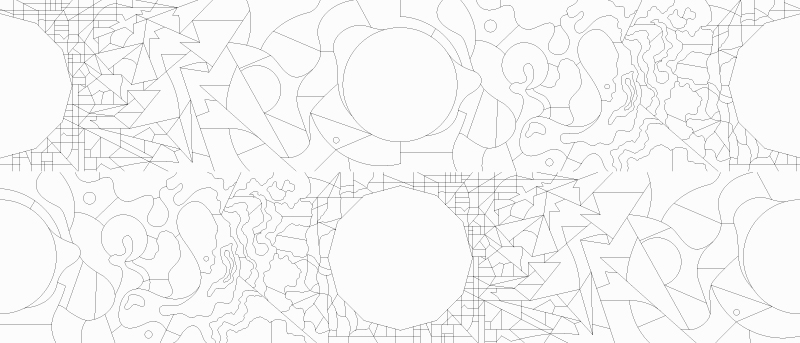On Vimeo
The Mural is the first in a series of projects through which I attempt to capture a temporal snapshot of some aspect of the web and render it into something meaningful and unexpected. For this project I downloaded 360 of the most recently posted clips from youtube over the course of about two hours on Feb. 27th, 2010. The idea was to get a sampling based on nothing other than temporal proximity, and dump that sampling into a template to see what it might look like and what questions it provoked. In concept, the template is dynamic, pulling a freshly uploaded clip in to fill each tile as the old clip finishes playing, creating a self perpetuating, always changing video mural which, in a sense, performs the overwhelming activity of YouTube as a massive stained glass hyper-window.

My original inspiration for this project was Marco Brambilla’s “Civilization” piece, and I had hoped to mimic in some sense the aesthetic panache and theological weight that he was able to craft. In that sense this project was a complete failure. The formal qualities of the template that I designed became lost when filled with the madness of the clips, as did the cosmological narrative I had in mind when designing it. Rather than synthesizing a span of time into a cohesive whole more meaningful than the sum of it’s parts, I succeeded in creating what I regard as a sort of stained glass pile of trash. Still, the reasons for this are interesting, as is the pile itself. Nothing about the clips themselves have any relationship to the template I designed, or to anything at all save the time they were uploaded. And because the template didn’t even respect the temporal relationships of the clips, it obliterated the one metric by which some sense of meaningful order could be given them, making the random even more random. Not only that, but because of the total variety of unorthodox shapes most clips were reduced to mere abstractions of themselves, divesting them of meaning on an individual level.
As it turns out, these are all things I quite like about the piece. They provoke a different conversation that is perhaps more interesting than the one I had originally anticipated. The piece underscores the fact that on YouTube, as with much of the web, the bulk of the services rendered amount to little more than the collection of media garbage, not in the qualitative sense, but rather in the sense that most of it is, for all practical purposes, simply discarded. Terabyte after terabyte of clips that will never be watched, pictures that will never be viewed, and blog posts that will never be read. And even if they are, all of it is so ephemeral and so quickly turned over that almost everything that was consumed yesterday has already been buried under an avalanche of new content. In most cases, none of it will be missed or ever revisited. Which begs the question — what do we like more about the internet: it’s ability to help us remember, or its ability to help us forget?
2 Comments
Re-posting this from Facebook.
Very good stuff, Chris.
I’m especially intrigued by the last couple paragraphs or so. There have been many people who have, for lack of a better term, by-and-large written off the web and web 2.0. This is due mostly to the web’s constant stream of useless information. As you said, the bulk of the services render little more than media garbage.
With so much accessible information–being that we can now look up almost any single fact in a matter of milliseconds–does our biological memory begin to become less useful? Or, conversely, does it merely change the way we use our memory?
My last year of college, I wrote a note to my Editing for News and Publications professor. On the back of my final exam, I explained I wouldn’t be rehearsing information I memorized from the textbook in writing, because it was useless for me to remember. The facts asked for in the test, I stated, can be easily referenced on the web and verified through other means. So easily, in fact, that it’s nearly a waste for me to put in the effort of remembering them.
Because of the way he graded the exam, I got an “A” anyway by using my editing skills to get more than 100% on the practical portion of the test.
Perhaps this is a future trend?
Thanks Owen.
Yes, a great deal of user-generated content is less than high-quality, but the point that I’m making has more to do with volume than it does with quality. There is simply way too much content being generated way too quickly, regardless of quality, for anybody to keep up. This means that most content, even good content, becomes a sort of cultural waste product, prompting a re-imagining of massive server farms as massive media landfills, full of outdated and unloved stories.
As for positioning the Web as a replacement for personal memory, or rather, as a collective cybernetic memory, I think there is lots of interesting territory there. What is the role of education when the wealth of the worlds knowledge is instantly available to anyone anytime, and when services like Wolfram Alpha are capable of generating new combinations of knowledge on the fly? I’m not sure, but I imagine there are a lot of books and papers which already deal with these issues. I will say this: in many industries, design among them, the dream of an education that prepares you with the tools and technical knowledge necessary for a sustained career has already been thrown out the window. Things change too quickly, and the ability to learn what you need to know on an ad-hoc basis in order to get the job done is key. The Web is wonderful for that sort of thing.